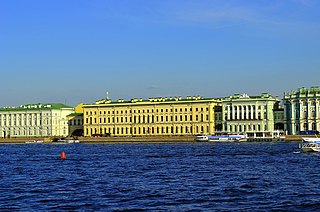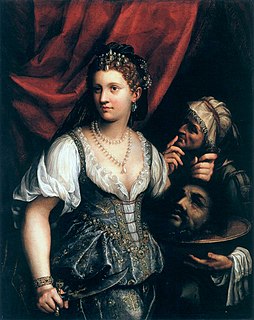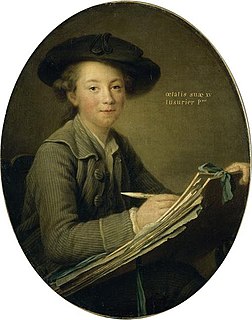Related Research Articles

The State Hermitage Museum is a museum of art and culture in Saint Petersburg, Russia. It is the largest art museum in the world by gallery space. It was founded in 1764 when Empress Catherine the Great acquired an impressive collection of paintings from the Berlin merchant Johann Ernst Gotzkowsky. The museum celebrates the anniversary of its founding each year on 7 December, Saint Catherine's Day. It has been open to the public since 1852. The Art Newspaper ranked the museum 6th in their list of the most visited art museums, with 1,649,443 visitors in 2021.

Annibale Carracci was an Italian painter and instructor, active in Bologna and later in Rome. Along with his brother and cousin, Annibale was one of the progenitors, if not founders of a leading strand of the Baroque style, borrowing from styles from both north and south of their native city, and aspiring for a return to classical monumentality, but adding a more vital dynamism. Painters working under Annibale at the gallery of the Palazzo Farnese would be highly influential in Roman painting for decades.

Antoine Coypel was a French painter, pastellist, engraver, decorative designer and draughtsman. He became court painter first to the Duke of Orléans and later to the French king. He became director of the Académie Royale. He was given the title of Garde des tableaux et dessins du roi, a function which combined the role of director and curator of the king's art collection. He was raised to the nobility by the French king. He is known for his history paintings, biblical, mythological and allegorical works, portraits and genre scenes.

Lavinia Fontana was a Bolognese Mannerist painter active in Bologna and Rome. She is best known for her successful portraiture, but also worked in the genres of mythology and religious painting. She was trained by her father Prospero Fontana who was a teacher at the School of Bologna. She is regarded as the first female career artist in Western Europe as she relied on commissions for her income. Her family relied on her career as a painter, and her husband served as her agent and raised their 11 children. She was perhaps the first woman artist to paint female nudes, but this is a topic of controversy among art historians.

Flemish painting flourished from the early 15th century until the 17th century, gradually becoming distinct from the painting of the rest of the Low Countries, especially the modern Netherlands. In the early period, up to about 1520, the painting of the whole area is typically considered as a whole, as Early Netherlandish painting. This was dominated by the Flemish south, but painters from the north were also important. Dutch and Flemish Renaissance painting, of which Antwerp became the centre, covers the period up to about 1580 or later, by the end of which the north and south Netherlands had become politically separated. Flemish Baroque painting was especially important in the first half of the 17th century, dominated by Rubens.

The Sleeping Hermaphroditus is an ancient marble sculpture depicting Hermaphroditus life size. In 1620, Italian artist Gian Lorenzo Bernini sculpted the mattress upon which the statue now lies. The form is partly derived from ancient portrayals of Venus and other female nudes, and partly from contemporaneous feminised Hellenistic portrayals of Dionysus/Bacchus. It represents a subject that was much repeated in Hellenistic times and in ancient Rome, to judge from the number of versions that have survived. Discovered at Santa Maria della Vittoria, Rome, the Sleeping Hermaphroditus was immediately claimed by Cardinal Scipione Borghese and became part of the Borghese Collection. The "Borghese Hermaphroditus" was later sold to the occupying French and was moved to The Louvre, where it is on display.

The Alba Madonna is a tondo (circular) oil on wood transferred to canvas painting by the Italian High Renaissance artist Raphael, created c. 1511, depicting Mary, Jesus, and John the Baptist in a typical Italian countryside.

Fede Galizia, better known as Galizia, was an Italian Renaissance painter of still-lifes, portraits, and religious pictures. She is especially noted as a painter of still-lifes of fruit, a genre in which she was one of the earliest practitioners in European art. She is perhaps not as well known as other female artists, such as Angelica Kauffman and Élisabeth Vigée Le Brun, because she did not have access to court-oriented or aristocratic social circles, nor had she sought the particular patronage of political rulers and noblemen.

By the Seashore is a painting by Pierre-Auguste Renoir completed in 1883 and is now housed in the Metropolitan Museum of Art in New York City.
Orsola Maddalena Caccia, born Theodora Caccia (1596–1676) was an Italian mannerist painter and Catholic nun. She painted religious images, altarpieces, and still lifes.

St. George and the Dragon is a small oil on wood cabinet painting by the Italian High Renaissance artist Raphael, painted c. 1505, and now in the National Gallery of Art in Washington, D.C. The saint wears the blue garter of the English Order of the Garter, reflecting the award of this decoration in 1504 to Raphael's patron Guidobaldo da Montefeltro, Duke of Urbino, by King Henry VII of England. The first word of the order's motto, "HONI" can be made out. The painting was presumably commissioned by the Duke, either to present to the English emissary who brought the regalia to Urbino, Sir Gilbert Talbot, or to Henry himself—recent scholarship suggests the latter. The honour paid to a minor Italian ruler reflected Henry's appreciation of the cultural prestige of Renaissance Italy as much as any diplomatic purpose.

Marie-Thérèse Reboul, commonly called Madame Vien, was a French painter and engraver of natural history subjects, still lifes, and flowers.
Kathryn Jane Brown is a British art historian and Lecturer in Art History and Visual Culture at Loughborough University.

Lucrina Fetti was an Italian painter born in Rome under the name Giustina She was the daughter of a lesser-known painter, Pietro Fetti, and the sister and pupil of the more distinguished painter of the family, Domenico Fetti. She accompanied her family to Mantua when her brother was invited to be court painter to Ferdinando Gonzaga, Duke of Mantua. On December 3, 1614, Duke Ferdinando exclusively gave Giustina a dowry of 150 scudi so she could become a Clarissan nun in the Convent of St. Ursula. Once she entered the convent, she chose to change her name to "Lucrina". She was known for her religious works from her family's workshop. They were mostly meant for decorations for the church and convent that were sponsored by Margherita Gonzaga, Duchess of Ferrara. She was also known for doing portraits of the women of the Gonzaga family.

Venus and Cupid is a circa 1626 painting by Artemisia Gentileschi in the Virginia Museum of Fine Arts. Venus and Cupid is a depiction of a sleeping Venus, who reclines on a blue bed covering and rich crimson and gold tasseled pillow. She wears nothing except a thin wisp of transparent linen around her thigh. Her son Cupid fans her with richly colored peacock feathers as she drifts to sleep. He is gazing at her with an adored, raptured expression. In the background, there is a window looking out onto a moonlight landscape where a temple to the goddess lies. Venus's face has full cheeks, heavy lids, a prominent nose, and small protruding chin—all features of Gentileschi's own face. The body movements are natural: Venus's hand rests lightly on her side, her legs are gently laid together. The work blends together realism and classicism through its iconography and the artist's style.

Catherine Lusurier (1752–1781) was a French painter.
Arsène Trouvé was a French painter, active during the nineteenth century.
Brenda Miller is an American post-minimalist visual artist. She has shown her work in the 1973 Whitney Biennial, as well as eight exhibitions at the Museum of Modern Art. Born in the Bronx, she studied at Parsons and University of New Mexico, and received and MFA from Tulane University in 1967, before moving back to New York City. She received three National Endowment for the Arts Fellowships. Her work is in the collections of the Smithsonian American Art Museum, Whitney Museum of American Art, Museum Boijmans Van Beuningen, and the Harvard Art Museums.

The Pastoral Concert or Le Concert Champêtre is an oil painting of c. 1509 attributed to the Italian Renaissance master Titian. It was previously attributed to his fellow Venetian and contemporary Giorgione. It is now in the Musée du Louvre in Paris.
Maura Reilly is Director of the Zimmerli Art Museum at Rutgers University. She has dedicated her career as an author and curator to underrepresented artists, especially women.
References
- ↑ Sandomir, Richard (25 February 2018). "Lee Harris Pomeroy, 85, Dies; Architect Revived Subway Stations". The New York Times .
- 1 2 3 Elman; Rinnhofer; Cheek (27 June 2017). "Jordana Pomeroy — Being Expansive at the Patricia & Phillip Frost Art Museum". Inspicio - Florida International University.
- 1 2 Dunseyar, Sarah (18 March 2015). "Profile: Jordana Pomeroy". Miami Today .
- ↑ Miller, Robin. "Jordana Pomeroy leaves LSU Museum of Art for post in Florida". The Advocate.
- ↑ "JORDANA POMEROY NAMED NEW DIRECTOR AT FIU FROST ART MUSEUM". Artforum.com.
- ↑ Safronova, Valeriya (19 October 2016). "On Debate Night, Celebrating a Book About Immigrants". The New York Times.
- ↑ LICON, Adriana Gomez (November 27, 2021). "Bob Dylan artwork show to open in Miami". NY Daily News .
- ↑ "Louisiana State University names Jordana Pomeroy Executive Director of Museum of Art". artdaily.cc.
- ↑ Broude, Norma (1 September 2013). "Royalists to Romantics: Women Artists from the Louvre, Versailles, and Other French National Collections. Exhibition organized and on view at the National Museum of Women in the Arts, Washington, D.C., 24 February 2012—29 July 2012, Jordana Pomeroy, Laura Auricchio, Melissa Lee Hyde, and Mary D. Sheriff". Early Modern Women. 8: 329–339. doi:10.1086/EMW23617859. ISSN 1933-0065.
- ↑ Chrisman-Campbell, Kimberly (2012). "Review of Royalists to Romantics: Women Artists from The Louvre, Versailles, and Other French National Collections". Woman's Art Journal. 33 (2): 62–64. ISSN 0270-7993.
- ↑ Reviews of Intrepid Women
- Faxon, Alicia Craig (2006). "Review of Intrepid Women: Victorian Artists Travel". Woman's Art Journal. 27 (2): 40–41. ISSN 0270-7993.
- PALMER, CAROLINE (2009). "Local/Global: Women Artists in the Nineteenth Century edited by Deborah Cherry and Janice Helland; Intrepid Women: Victorian Artists Travel edited by Jordana Pomeroy; Critical Voices: Women and Art Criticism in Britain 1880-1905 by Meaghan Clarke". Gender & History . 21 (2): 444–448. doi:10.1111/j.1468-0424.2009.01557_11.x.
- Dykes, Melissa. "Melissa Dykes's Review of Monica Anderson's Women and the Politics of Travel, 1870-1914 and Jordana Pomeroy's Intrepid Women: Victorian Artists Travel • Issue 3.3 • Nineteenth-Century Gender Studies". Nineteenth-Century Gender Studies.
- ↑ Rhodes, Kimberly (2009). "She's Leaving Home: Mapping Nineteenth-Century Women and the Visual Arts". Journal of Women's History. 21 (4): 205–212. doi:10.1353/jowh.0.0104. ISSN 1527-2036.
- ↑ Reviews of Italian Women Artists
- Quin, Sally (2008). "Italian Women Artists from Renaissance to Baroque (review)". Parergon. 25 (1): 217–219. doi:10.1353/pgn.0.0048. ISSN 1832-8334.
- Och, Marjorie (2007). "Review of Italian Women Artists from Renaissance to Baroque, National Museum of Women in the Arts, Washington, D.C., March 16 through July 15, 2007". Early Modern Women. 2: 193–197. ISSN 1933-0065.
- Poole, Katherine M. (2008). "Review of Italian Women Artists from Renaissance to Baroque". Woman's Art Journal. 29 (1): 41–43. ISSN 0270-7993.
- ↑ Reviews of An Imperial Collection
- Hilton, Alison (2004). "Review of An Imperial Collection: Women Artists from the State Hermitage Museum". Woman's Art Journal. 25 (2): 33–35. doi:10.2307/3566516. ISSN 0270-7993.
- Mesropova, Olga (2004). "Review of An Imperial Collection: Women Artists from the State Hermitage Museum". Canadian Slavonic Papers / Revue Canadienne des Slavistes. 46 (3/4): 515–516. ISSN 0008-5006.